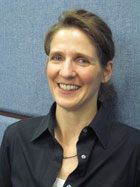ASk A Researcher
February 2013
Learn about the powerful data resource known as the American Community Survey (ACS)
Karen Olson, North Dakota Compass
 Compass researcher Karen Olson provides background regarding one of the best federal data sources available for comprehensive social and economic information, especially for less-populated, rural areas.
Compass researcher Karen Olson provides background regarding one of the best federal data sources available for comprehensive social and economic information, especially for less-populated, rural areas.
Approximately 22,000 children living in North Dakota are impoverished. Approximately one in four North Dakota households spend 30 percent or more of their household income on housing costs. This information, available through ND Compass, comes from the American Community Survey (ACS), a Census Bureau poll sent to 3.5 million U.S. households each year. The knowledge obtained from this survey helps target federal, state, and local government spending on those who need it most.
Because so much important planning occurs at the community level (schools, transportation systems, housing), having annual data is vital for individuals in smaller rural and urban communities to make data-driven decisions. Here at North Dakota Compass, we use the ACS data extensively to assist community and state leaders, nonprofits, and educators make the necessary decisions to move North Dakota forward.
So, what is the American Community Survey?
The U.S. Census Bureau’s American Community Survey (ACS) is part of the constitutionally required decennial census. Historically, the census was conducted in two parts: the short form which counted the population and the long form which contained detailed questions regarding social and economic conditions. This long form became the prominent source of detailed data (e.g., educational attainment, poverty, income, occupation, housing) for large and small communities across the nation – a boon for researchers and policy makers everywhere. However, since the data were collected just every 10 years, the data became less and less representative as the decade progressed.
The Census Bureau responded to this challenge by designing the ACS, a new data collection system to replace the traditional long form, which was fully implemented in 2006 (see detailed information regarding the ACS).
The Census Bureau uses a series of monthly samples to produce annually updated ACS data for the same geographic areas surveyed via the decennial census long form. The Census Bureau uses a three-tiered data collection process for the ACS. Geographic areas of at least 65,000 people are large enough to produce reliable period estimates after 12 months of data collection. In contrast, geographic areas of 20,000 to 65,000 people require 36 months of data collection, and areas smaller than 20,000 people require 60 months of continuous data collection to produce reliable estimates.
It is important to understand that ACS data capture events that occur over a period of time (i.e., one, three, or five years) rather than a single point in time. This can be a challenge if the characteristic being examined is dynamic or fluctuates from year to year. Another important consideration is that most North Dakota geographies (e.g., counties, cities, townships, reservations, neighborhoods) have fewer than 20,000 people and require five years of data collection.
However, these challenges should not diminish the opportunity the data provide in creating a richer understanding of North Dakota residents and communities.
To assist us in using and interpreting ACS data, the Census Bureau has put together a series of handbooks, each focusing on a specific data user (e.g., businesses, researchers, teachers, congress, the media, and any user of data).
Explore ACS data on ND Compass:
Cost-burdened households
Disability data
Educational attainment
Health care coverage
Homeownership rate
Median income
Poverty
Proportion of adults working
